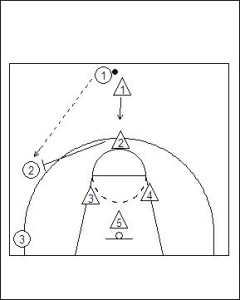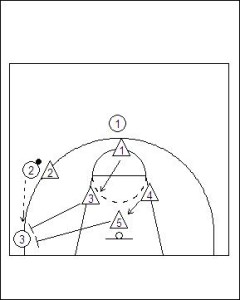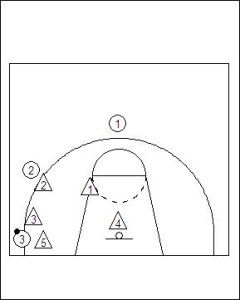1-1-2-1 Diamond Trap: A Quarter Court Trapping Defence
The 1-1-2-1 Diamond Trap is a very interesting zone trapping option. Like all zone defences, the 1-1-2-1 Diamond Trap has a number of unique characteristics that help define its specialist purpose. The 1-1-2-1 Diamond Trap is a fantastic change-up defence that can be highly effective as a tool to disrupt a team’s tempo and style of play.
One of the strengths of the 1-1-2-1 Diamond Trap is in the initial set–up the formation of the zone defence that extends defensive pressure all the way to halfway. This ensures that from the moment the ball moves across halfway the offense is channelled into the sidelines of the court. In this situation, the second and third line of defenders can move into positions that apply pressure to offensive player’s one pass away targets from the ball to ensure there is no easy pressure release.
Secondly, the 1-1-2-1 Diamond Trap looks to create a danger area for offences where generally there would be a weakness. In a 1-1-2-1 zone formation there is an inherent danger when the ball is moved to the long corners on either side of the floor. The 1-1-2-1 Diamond Trap looks is initiate a trap once the ball is passed into this area. For this tactic to be effective however the defensive players must overload the strong side of the floor prior to the pass finally being made into the long corner. The defensive players involved in the trapping effort must be very active and ensure they move on the flight of the ball as soon as the pass is in the air.
The third aspect which makes the 1-1-2-1 Diamond Trap effective is the rotations into the trapping position. With many trapping defences in the half court, one of the defenders usually comes to form the trap by following a pass. For example Two (2) rotating down to Three (3) in the diagrams below. However, with the 1-1-2-1 Diamond Trap the players involved in the trap come from off the ball. This ensures the easiest and often quickest pressure release pass back to the wing is denied and a longer and subsequently slower skip pass has to be made out of the long corner with the offensive player being guarded by two defenders. This a tough ask at the best of time.

Rule: Players must move on flight of ball to offensive player. Arriving late will only weaken the ability for the trap to occur.
One (1) marks the ball handler and channels the ball to one side of the floor.
Two (2) will move to guard he first in the half court. Two (2) can start to anticipate by moving towards the likely side of the floor the pass with be made to. Two (2) must not commit early, but rather move on the flight of the ball.
One (1) replaces Two (2) at top of free throw circle preventing the ball being reversed back along the three-point line.
If there is a high post player, One (1) can also assist with denying a pass to this player by being in an open stance and being within an arm’s reach of the post player.

Rule: When the ball is passed into the long corner the trap is initiated.
Two (2) jumps into passing lane preventing ball being reversed.
Three (3) and Five (5) close-out aggressively to the ball.
One (1) replaces Three (3).
Four (4) replaces Five (5).

Defenders creating the trap contain the ball. This pressure is as much about body positioning as active hands that shadow the ball.
One (1) and Four (4) bump cutters and move into passing lanes stopping a pass.
The 1-1-2-1 Diamond Trap helps break the rhythm of an offensive team with in some ways, unconventional trapping principles, and rotations. In some circumstances, this will be enough to change dramatically the style of offensive play implemented by a team.
Related articles







